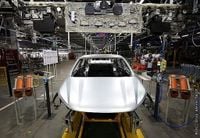On April 19, 2025, AVTOVAZ officially launched the mass production of the new Lada Iskra at its Tolyatti plant, marking a significant milestone for the company. The introduction of this model coincides with the 55th anniversary of the production of the iconic VAZ-2101, commonly known as the "kopeyka." The Lada Iskra is set to fill a market niche between the existing Lada Granta and Vesta models, showcasing a blend of modern technology and design.
The Iskra is built on a deeply redesigned version of the CMF-B-LS platform originally developed by Renault, which has undergone extensive localization. According to AVTOVAZ, over 1,000 new components and parts were integrated into the Iskra, with more than 400 of these undergoing re-engineering to enhance performance and reliability. This technological independence is a significant step for AVTOVAZ, especially following the departure of Renault from the Russian market.
During the launch ceremony, Anton Alihanov, the Russian Minister of Industry and Trade, emphasized the vehicle's modern features, stating, "Lada Iskra is indeed a modern car that meets all safety and comfort requirements. I am confident it will be in demand despite macroeconomic challenges." The first day of production saw 12 units of the Lada Iskra assembled in various modifications, demonstrating the company's readiness to meet consumer demands.
The Lada Iskra will be available in three body styles: sedan, station wagon, and a cross-version. The sedan and the standard station wagon measure 4,333 mm in length, which is 65 mm longer than the Granta sedan and 107 mm shorter than the Vesta sedan. The Iskra Cross variant is slightly longer at 4,342 mm, providing additional space and functionality.
In terms of engine options, buyers can choose from three configurations: an 8-valve 1.6-liter engine producing 90 horsepower coupled with a 5-speed manual gearbox, a 16-valve 1.6-liter engine generating 106 horsepower with a 6-speed manual transmission, or a 1.6-liter engine with the same output paired with a continuously variable transmission (CVT). The ground clearance is set at 170 mm for the sedan and standard station wagon, while the Cross version boasts a clearance of 200 mm, making it well-suited for diverse driving conditions.
AVTOVAZ has also focused on safety and comfort in the Iskra. The car will come equipped with front airbags, an electronic stability control system (ESC), and anti-lock braking system (ABS). The interior features a dashboard with an original design, offering practicality with dual cup holders that can accommodate both standard paper cups and 0.5-liter bottles. Additionally, the fuel tank can now be unlocked from inside the vehicle, a first for AVTOVAZ models, providing added convenience for drivers.
The production facilities at AVTOVAZ have been upgraded, allowing for an annual output of up to 150,000 units of the Lada Iskra. However, the actual production numbers will depend on market demand, especially given the current economic climate affecting the automotive industry in Russia. In the first quarter of 2025, sales of passenger cars and light commercial vehicles dropped by 24.7%, with Lada's sales decreasing by 16.8% during the same period.
Official sales of the Lada Iskra are slated to commence on July 20, 2025, coinciding with the company's anniversary. The base price for the sedan is projected to start at 1.2 million rubles, which positions it competitively in the market. As the launch date approaches, more details regarding the various trim levels and pricing will be unveiled.
The Lada Iskra represents not just a new model but a significant step forward for AVTOVAZ in terms of innovation and adaptation to market needs. As the company seeks to reclaim its footing in a challenging economic landscape, the Iskra may well become a pivotal player in the Russian automotive market.








